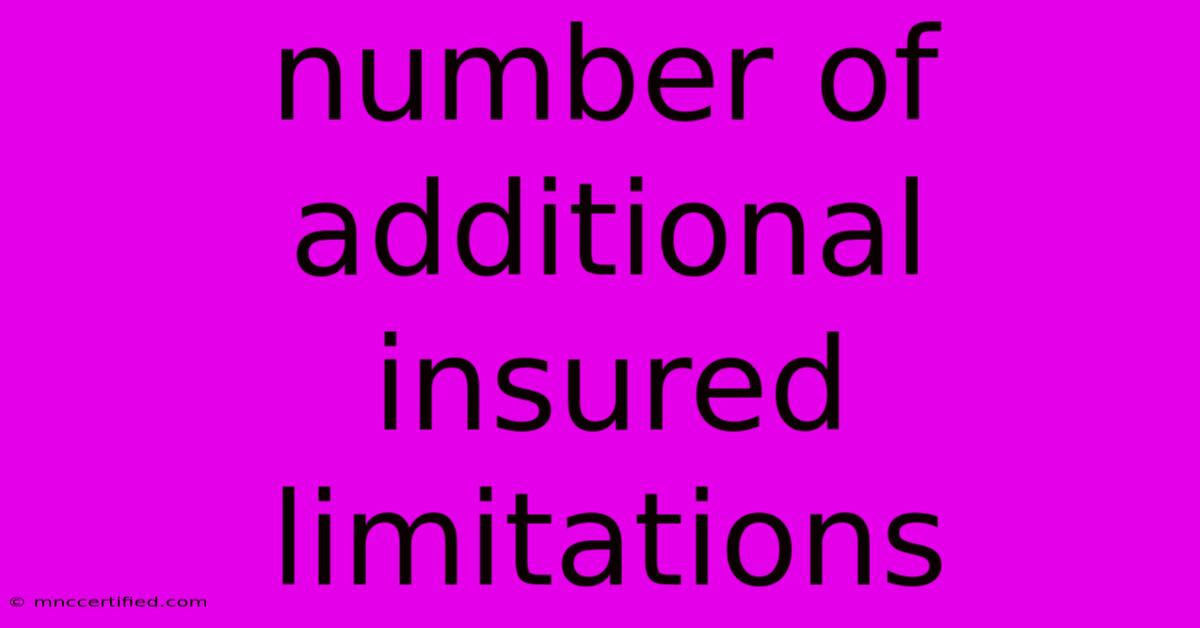Number Of Additional Insured Limitations

Table of Contents
Navigating the Labyrinth: Understanding Number of Additional Insured Limitations in Insurance Policies
In the world of insurance, understanding the intricacies of your policy is crucial. One aspect that can be particularly confusing is the concept of additional insureds and the limitations placed on their coverage.
While adding an additional insured to your policy can seem like a simple process, the details of these limitations can have significant consequences in the event of a claim. This article will delve into the complexities of these limitations and help you understand their implications.
What are Additional Insureds?
An additional insured is an individual or entity, other than the named insured, who is granted coverage under an insurance policy. This coverage can extend to various liabilities, such as:
- Property damage: If an additional insured is involved in an accident causing damage to your property, they may be covered under your policy.
- Bodily injury: If an additional insured injures someone, they may be covered for medical expenses or legal fees.
- Other liabilities: Depending on the specific policy language, additional insureds might be covered for other liabilities related to your business or property.
Why are Additional Insured Limitations Important?
While including additional insureds might seem beneficial, there are several reasons why these limitations matter:
- Financial Implications: In the event of a claim, coverage limits for the additional insured may be reduced, or they may be excluded entirely from coverage.
- Scope of Coverage: The specific types of risks covered for additional insureds can be limited compared to the named insured.
- Contractual Agreements: The need for additional insured endorsements arises from contractual obligations between parties. These endorsements often contain specific limitations to protect the insurer's interests.
Common Limitations on Number of Additional Insureds
Insurance policies frequently incorporate limitations on the number of additional insureds that can be added. Here are some common types:
- Maximum Number: The policy may specify a maximum number of additional insureds allowed.
- Tiered Coverage: Policies may offer different levels of coverage depending on the type of additional insured, with higher levels requiring additional premiums.
- Specific Requirements: Policies may require specific information or documentation to be provided for each additional insured, such as a certificate of insurance or a contract outlining the relationship between the insured parties.
Examples of Number of Additional Insured Limitations
Here are a few real-world scenarios that demonstrate the impact of these limitations:
- Construction Project: A general contractor requires a subcontractor to be added as an additional insured on their liability insurance policy. However, the policy has a limit of two additional insureds, and the general contractor has already reached this limit. The subcontractor may need to obtain their own insurance or negotiate a separate agreement.
- Property Lease: A landlord requires a tenant to be added as an additional insured on their property insurance policy. The policy has a tiering system, with a higher premium for "commercial tenants" compared to "residential tenants." If the tenant operates a business in the leased space, the landlord may need to pay an increased premium to include them.
Navigating the Limitations
To avoid any surprises during a claim, it is essential to:
- Read your policy carefully: Understand the specific limitations related to additional insureds before adding any party to your policy.
- Consult with your insurance agent: They can help you interpret the policy language and understand the implications of adding additional insureds.
- Negotiate with other parties: When contractual obligations require the addition of additional insureds, be prepared to negotiate the terms and conditions of coverage.
Conclusion
Understanding the limitations on the number of additional insureds in your insurance policy is crucial for protecting your financial interests. By carefully reviewing the policy language and consulting with your insurance agent, you can ensure that any additional insureds are appropriately covered and that you are adequately protected from potential risks.

Thank you for visiting our website wich cover about Number Of Additional Insured Limitations. We hope the information provided has been useful to you. Feel free to contact us if you have any questions or need further assistance. See you next time and dont miss to bookmark.
Featured Posts
-
Capitals Jingle Bell Ball Returns
Nov 07, 2024
-
Does A Cracked Windshield Raise Insurance
Nov 07, 2024
-
Ranked Choice Voting Lurie Ahead In Sf Mayor Race
Nov 07, 2024
-
New York Man Arrested Accused Of Terror Support
Nov 07, 2024
-
Bayern Munich Vs Benfica Team News Lineups
Nov 07, 2024